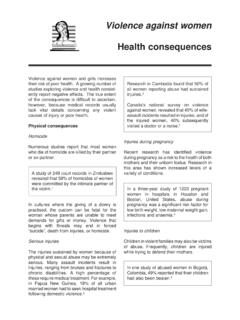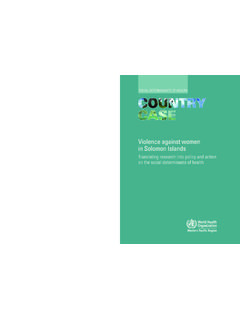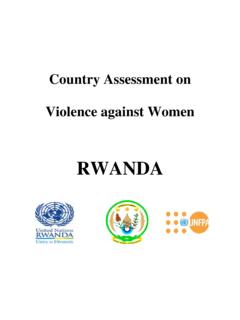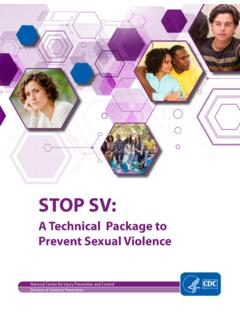Transcription of Promoting gender equality to prevent violence against women
1 Promoting gender equality to prevent violence against womenSeries of briefings on violence preventionThis briefing for advocates, programme designers and implementers and others is one of a seven-part series on the evidence for interventions to prevent interpersonal and self-directed violence . The other six briefings look at reducing access to lethal means; increasing safe, stable and nurturing relationships between children and their parents and caregivers; developing life skills in children and adolescents; reducing availabil-ity and misuse of alcohol; changing cultural norms that support violence ; and victim identification, care and support.
2 For a searchable evidence base on interventions to prevent violence , please go to: a library of violence prevention publications, including the other briefings in this series, please go to: World Health Organization 2009 All rights reserved. Publications of the World Health Organization can be obtained from WHO Press, World Health Organization, 20 Avenue Appia, 1211 Geneva 27, Switzerland (tel.: +41 22 791 3264; fax: +41 22 791 4857; e-mail: Requests for permission to reproduce or translate WHO publications whether for sale or for noncommercial distribution should be addressed to WHO Press, at the above address (fax: +41 22 791 4806.))
3 E-mail: The designations employed and the presentation of the material in this publication do not imply the expression of any opinion whatsoever on the part of the World Health Organization concerning the legal status of any country, territory, city or area or of its authorities, or concerning the delimitation of its frontiers or boundaries. Dotted lines on maps represent approximate border lines for which there may not yet be full agreement. The mention of specific companies or of certain manufacturers products does not imply that they are endorsed or recommended by the World Health Organization in preference to others of a similar nature that are not mentioned.
4 Errors and omissions excepted, the names of proprietary products are distinguished by initial capital reasonable precautions have been taken by the World Health Organization to verify the information contained in this publication. However, the published material is being distributed without warranty of any kind, either expressed or implied. The responsibility for the interpretation and use of the material lies with the reader. In no event shall the World Health Organization be liable for damages arising from its use. Designed by minimum graphicsPrinted in MaltaWHO Library Cataloguing-in-Publication DataPromoting gender equality to prevent violence against women .
5 (Series of briefings on violence prevention: the evidence) prevention and control. s health. violence prevention and control. rights. identity. abuse. problems. Health Organization. ISBN 978 92 4 159788 3 (NLM classification: HV 6625)1 Promoting gender equality TO prevent violence against WOMENO verviewPromoting gender equality is a critical part of violence prevention. The relationship between gender and violence is complex. Evidence suggests, however, that gender inequalities increase the risk of violence by men against women and inhibit the ability of those affected to seek protection.
6 There are many forms of violence against women ; this briefing focuses on violence by intimate partners, the most common form. Though further research is needed, evidence shows that school, community and media interventions can promote gender equality and prevent violence against women by challenging stereotypes that give men power over women . School initiatives are well placed to prevent violence against women . School-based programmes can address gender norms and attitudes before they become deeply ingrained in children and youth. Such initiatives address gender norms, dating violence and sexual abuse among teenagers and young adults.
7 Positive results have been reported for the Safe Dates programme in the United States of America and the Youth Relationship Project in Canada. Community interventions can empower women and engage with interventions can address gender norms and attitudes through, for example, the combination of microfinance schemes for women and methods that empower men as partners against gender -based violence . The strongest evidence is for the IMAGE microfinance and gender equity initiative in South Africa and the Stepping Stones programme in Africa and Asia. Community programmes with male peer groups show promise in changing attitudes towards traditional gender norms and violent behaviour, but they require more rigorous evaluations.
8 Well-trained facilitators and community ownership appear to boost the effectiveness of these interventions can alter gender norms and promote women s rights. Public awareness campaigns and other interventions delivered via television, radio, newspapers and other mass media can be effective for altering attitudes towards gender norms. The most successful are those that seek to understand their target audience and engage with its members to develop content. We do not yet know, however, whether they actually reduce violence . Programmes must engage males and is some evidence that microfinance schemes that empower women (without engaging with men) may actually cause friction and conflict between partners, especially in societies with rigid gender roles.
9 Further research is needed to explore how such possible negative effects might be overcome. BOX 1 Definitions gender equality : Equal treatment of women and men in laws and policies, and equal access to resources and services within families, communities and society at large (11). gender EQUITY: Fairness and justice in the distribution of benefits and responsibilities between women and men. Programmes and policies that specifically empower women are often needed to achieve this (11). gender -BASED violence : violence involving men and women , in which the female is usually the victim; and which is derived from unequal power relationships between men and women .
10 violence is directed specifically against a woman because she is a woman, or affects women disproportionately. It includes, but is not limited to, physical, sexual and psychological harm (including intimidation, suffering, coercion, and/or deprivation of liberty within the family, or within the general community). It includes that violence which is perpetrated or condoned by the state (13). This widely accepted definition of gender -based violence is now often expanded to include violence that results from unequal power relations between men and between women ( homophobic violence ). violence against women : Any public or private act of gender -based violence that results in, or is likely to result in physical, sexual or psychological harm or suffering to women , including threats of such acts, coercion or arbitrary deprivation of liberty (14).
















